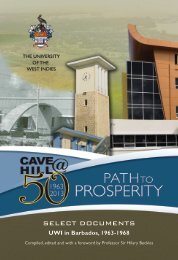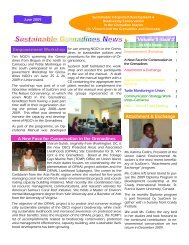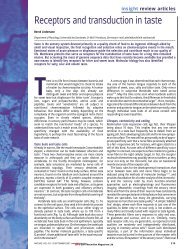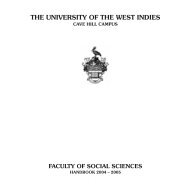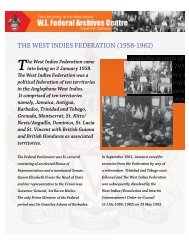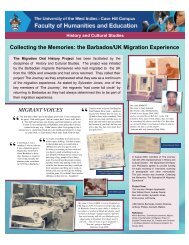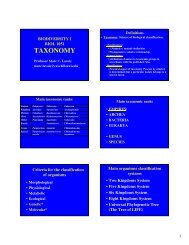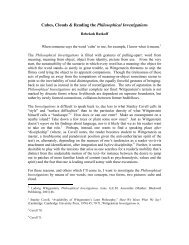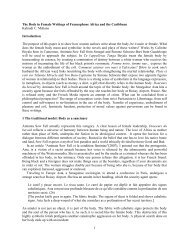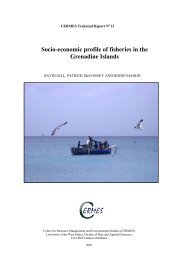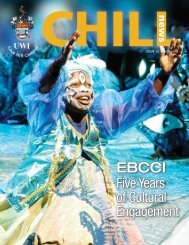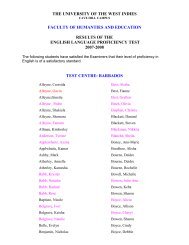THE SUSTAINABLE GRENADINES PROJECT - The University of ...
THE SUSTAINABLE GRENADINES PROJECT - The University of ...
THE SUSTAINABLE GRENADINES PROJECT - The University of ...
You also want an ePaper? Increase the reach of your titles
YUMPU automatically turns print PDFs into web optimized ePapers that Google loves.
This book provides an overview <strong>of</strong> the islands <strong>of</strong> the St. Vincent and the Grenadines and this is followed by pictures which<br />
illustrate the history, culture, life and biodiversity <strong>of</strong> the islands.<br />
Avian Eyes. 1999. Birds <strong>of</strong> Mustique. January 22-24 th . Mustique Island Company. 50 pp.*<br />
Result <strong>of</strong> a bird study conducted on Mustique during the period January 22 nd to the 24 th , 1999. <strong>The</strong> text contains data on<br />
terrestrial, marine, residential and migratory bird life on the island. <strong>The</strong> statuses <strong>of</strong> the species <strong>of</strong> birds are recorded at key<br />
watch points are included. Additionally, the factors that impact avifauna are discussed and recommendations for the<br />
conservation <strong>of</strong> this group <strong>of</strong> wildlife on Mustique.<br />
Babb, Y., S. Punnett, P. Medley, S. Singh-Renton. 2004: <strong>The</strong> Red Hind (Epinephelus guttatus) fishery <strong>of</strong> St. Vincent<br />
and the Grenadines. (A) Report <strong>of</strong> the Reef and Slope Fish Resource Working Group (RSWG), pp 27-39. In:<br />
Caribbean Regional Fisheries Mechanism (CRFM) (eds.) Report <strong>of</strong> the First Annual CRFM Scientific Meeting 22 –<br />
30 June 2004. CRFM Fishery Report No. 11.*<br />
This is a brief report on the red hind fishery in St. Vincent and the Grenadines. It begins to provide advice on management<br />
<strong>of</strong> the fishery due to the increased fishing effort on the species. Details on statistics and research recommendations were<br />
made to the Fisheries Division. <strong>The</strong> section on the scientific assessment is an exploratory analyses <strong>of</strong> the available<br />
biological and catch and effort data to examine patterns in size frequency distributions <strong>of</strong> the red hind species.<br />
Bailey, M. 1992. Case study on management <strong>of</strong> the Tobago Cays national marine park.<br />
Not seen.<br />
Bailey, M. 1994. Report on the Preliminary Reef Survey in Mustique from the 20 th to the 21 st June, 1994. Report<br />
prepared for the Mustique Company. 6 pp.<br />
No seen.<br />
Balcomb, K. 1981. Whale Reports from Bequia, St. Vincent Grenadines. Cetus, Vol. 3, No. 1, pp. 4-6.<br />
Not seen.<br />
Baldwin, K., R. Mahon, H.A. Oxenford , A. Cooke, D. Gill, T. Staskiewicz. 2006. A pr<strong>of</strong>ile <strong>of</strong> marine resource users<br />
in the Grenadine islands. Proceedings <strong>of</strong> the Gulf and Caribbean Fisheries Institute. In press.*<br />
<strong>The</strong> transboundary Grenadine island chain lies on the Grenada Bank stretching some 120 km between two countries,<br />
Grenada, and St. Vincent and the Grenadines. <strong>The</strong>re are over 30 islands, <strong>of</strong> which 9 have permanent settlements.<br />
Marinebased activities are the foundation <strong>of</strong> the economies <strong>of</strong> the Grenadine islands in which fishing, tourism and transport<br />
are the major sources <strong>of</strong> employment. It is recognised that a better understanding <strong>of</strong> the abundance and distribution <strong>of</strong> key<br />
marine resources, marine resource users (MRUs) and the patterns <strong>of</strong> use is critical to planning and the sustainable use <strong>of</strong><br />
these resources for social and economic development. <strong>The</strong> area has been chosen as a site for the development <strong>of</strong> an<br />
integrated participatory marine space-use information system (MarSIS). MarSIS will aid in marine planning as a tool to<br />
highlight areas for special management attention such as: critical habitats; representative marine ecosystems; areas <strong>of</strong> high<br />
aesthetic value and cultural importance; areas important for livelihoods: fishing grounds; marine-based tourism; areas <strong>of</strong><br />
highest human threat; as well as areas which currently or potentially are locations <strong>of</strong> space-use conflict. This transboundary<br />
marine resource user stakeholder assessment identified a total <strong>of</strong> 826 direct marine resource users (including fishers, dive<br />
shop operators, yachting companies, water-taxi operators, day tour operators, ferry operators and ship owners) and 519<br />
boats currently operating in the Grenadine islands. Three quarters <strong>of</strong> all MRUs identified were Vincentian, and 90% were<br />
male. Fishers made up the largest MRU group overall. <strong>The</strong> majority <strong>of</strong> MRUs interviewed believe that illegal activities<br />
pose the largest threat to the Grenadine marine environment and recommend increased management initiatives. <strong>The</strong>se<br />
pr<strong>of</strong>iles will be used to help identify community interests and aid the preparation <strong>of</strong> subsequent participatory marine<br />
resource mapping exercises, community-based management and space-use planning initiatives. It is envisioned that through<br />
transparent and equitable stakeholder involvement during all stages <strong>of</strong> the development <strong>of</strong> the MarSIS, social<br />
transformation through local empowerment and capacity building will aid effective collaborative management, allowing for<br />
5



